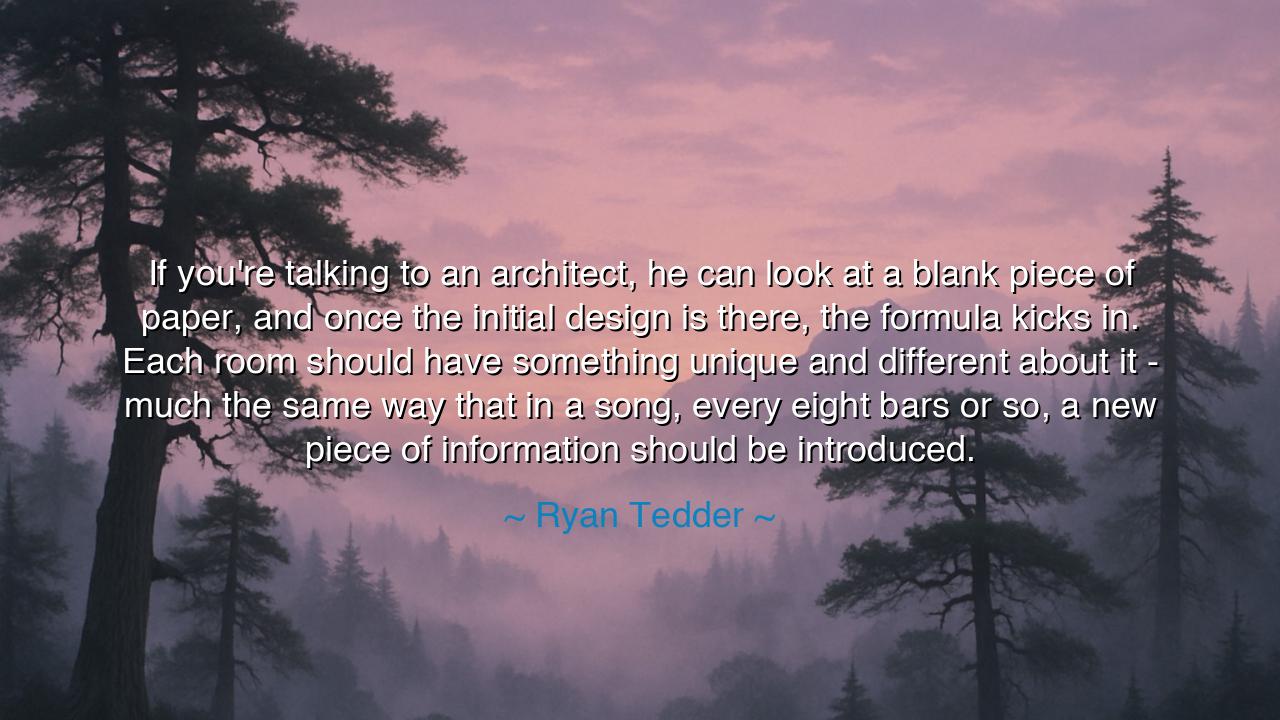
If you're talking to an architect, he can look at a blank piece
If you're talking to an architect, he can look at a blank piece of paper, and once the initial design is there, the formula kicks in. Each room should have something unique and different about it - much the same way that in a song, every eight bars or so, a new piece of information should be introduced.






“If you’re talking to an architect, he can look at a blank piece of paper, and once the initial design is there, the formula kicks in. Each room should have something unique and different about it — much the same way that in a song, every eight bars or so, a new piece of information should be introduced.” — Ryan Tedder
Thus spoke Ryan Tedder, master craftsman of melody and emotion, whose art bridges the worlds of sound and structure. In these words, he unveils a truth that reaches beyond music, beyond architecture — a truth about the creative process itself. For all creation, whether of buildings or of songs, begins with the blank page, the void from which form is born. The architect and the songwriter are kin: each must imagine beauty into being, balance chaos with order, and breathe life into structure. Tedder’s wisdom reminds us that artistry is not random inspiration, but design shaped by discipline, and that every great creation must balance unity with surprise — the familiar with the new.
When Tedder speaks of the architect gazing upon a blank piece of paper, he speaks of that sacred moment known to every creator — the silence before the first note, the emptiness before the first line, the stillness before the first vision. It is the moment of both terror and possibility, when the infinite must become finite. But once “the initial design is there,” as he says, “the formula kicks in.” This is not a formula of constraint, but of harmony — the set of principles that guide creativity into coherence. For even the wildest dream must take on form if it is to touch the human heart. As the ancients knew, creation is not chaos; it is order born of imagination.
Tedder’s insight goes deeper still. “Each room should have something unique and different about it,” he says — and so it must be in every song, every poem, every work of art. For sameness breeds numbness, and the spirit hungers for renewal. Just as the architect gives each chamber its own identity — a window here, a curve there, a hidden light where none expects it — so must the musician craft variation within unity. In music, as in architecture, repetition comforts the mind, but surprise awakens the soul. Each new eight bars is a door that opens into fresh emotion, a vista that keeps the listener moving through the house of sound.
Consider the genius of Ludwig van Beethoven, who built symphonies as cathedrals of sound. Within each movement, he introduced new motifs and textures that expanded the listener’s experience, just as a master builder expands the imagination with each turn of the corridor. His Fifth Symphony begins with the most familiar of themes — four fateful notes — yet with every eight bars, a new idea is revealed, until the entire structure unfolds like a temple of divine proportion. Beethoven, like Tedder, understood that art lives in evolution, that every passage must bring forth something unseen yet inevitable.
And what of the architect himself? Think of Frank Lloyd Wright, who declared that a house must grow out of its environment as naturally as a tree from the soil. In his masterpieces — Fallingwater, the Guggenheim — every room is distinct, yet every part serves the whole. Light, shadow, space, and rhythm weave together as though the building were a living organism. So too does the great songwriter weave melody, rhythm, and emotion — each phrase unique, yet all belonging to the same heart. Whether of stone or of sound, the principle is the same: the architecture of beauty is built on variation within unity.
Thus, Tedder’s words carry a lesson for all creators: design your work as you would design a dwelling for the spirit. Begin with vision, follow the discipline of craft, and let each part of your creation offer something new. Do not fear the blank page, for it is the womb of possibility. Do not resist structure, for it is the spine of beauty. And above all, do not let your art grow stagnant; breathe into it the rhythm of change, the pulse of discovery. For creation, like life, thrives in the balance between form and freedom.
So, my children, whether you build songs, stories, or dreams, remember what Ryan Tedder teaches: every work is a house for the soul. Let its foundations be strong, its rooms full of light, and its passages alive with surprise. For the architect and the artist share the same sacred duty — to take the emptiness of the world and fill it with meaning. And when every eight bars — or every step, or every moment — brings something new and true, your work will not merely be seen or heard. It will be lived.






AAdministratorAdministrator
Welcome, honored guests. Please leave a comment, we will respond soon